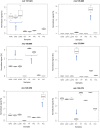Micro- and Nanoplastics in Alpine Snow: A New Method for Chemical Identification and (Semi)Quantification in the Nanogram Range
- PMID: 31951124
- PMCID: PMC7031848
- DOI: 10.1021/acs.est.9b07540
Micro- and Nanoplastics in Alpine Snow: A New Method for Chemical Identification and (Semi)Quantification in the Nanogram Range
Abstract
We present a new method for chemical characterization of micro- and nanoplastics based on thermal desorption-proton transfer reaction-mass spectrometry. The detection limit for polystyrene (PS) obtained is <1 ng of the compound present in a sample, which results in 100 times better sensitivity than those of previously reported by other methods. This allows us to use small volumes of samples (1 mL) and to carry out experiments without a preconcentration step. Unique features in the high-resolution mass spectrum of different plastic polymers make this approach suitable for fingerprinting, even when the samples contain mixtures of other organic compounds. Accordingly, we got a positive fingerprint of PS when just 10 ng of the polymer was present within the dissolved organic matter of snow. Multiple types of microplastics (polyethylene terephthalate (PET), polyvinyl chloride, and polypropylene carbonate), were identified in a snowpit from the Austrian Alps; however, only PET was detected in the nanometer range for both snowpit and surface snow samples. This is in accordance with other publications showing that the dominant form of airborne microplastics is PET fibers. The presence of nanoplastics in high-altitude snow indicates airborne transport of plastic pollution with environmental and health consequences yet to be understood.
Conflict of interest statement
The authors declare no competing financial interest.
Figures



References
-
- Bond T.; Ferrandiz-Mas V.; Felipe-Sotelo M.; van Sebille E. The Occurrence and Degradation of Aquatic Plastic Litter Based on Polymer Physicochemical Properties: A Review. Crit. Rev. Environ. Sci. Technol. 2018, 48, 685–722. 10.1080/10643389.2018.1483155. - DOI
-
- Mintenig S. M.; Bäuerlein P. S.; Koelmans A. A.; Dekker S. C.; van Wezel A. P. Closing the Gap between Small and Smaller: Towards a Framework to Analyse Nano- and Microplastics in Aqueous Environmental Samples. Environ. Sci.: Nano 2018, 5, 1640–1649. 10.1039/C8EN00186C. - DOI
Publication types
MeSH terms
Substances
LinkOut - more resources
Full Text Sources

